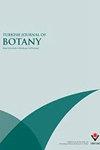土耳其石竹科石竹属植物染色体数目及基因组大小资料
IF 1.5
4区 生物学
Q3 PLANT SCIENCES
引用次数: 0
摘要
基因组大小,即未复制体细胞核中DNA的总量,被认为是生物体生物学中的一个重要特征,鉴于所报道的非凡多样性,它与陆地植物尤其相关。尽管数据的不断增长和努力旨在提高我们对植物基因组大小多样性的理解,但需要更多的数据来均匀地代表不同谱系。在这个前提下,在这项工作中,我们研究了基因组大小,并补充了来自土耳其石竹属(石竹科)的八个物种的染色体数据。染色体计数表明,所研究的物种是二倍体,除了一个物种,P. saxifraga,可能是四倍体,根据先前发表的核DNA含量估计。基本染色体数目x = 15和x = 13的存在被证实,后者仅限于种P. hispidula和P. cretica。对土耳其特有种P. hispidula (2n = 26)、P. pamphylica (2n = 30)和P. peroninii (2n = 30)进行的计数代表了该属的新数据。核DNA含量为1.24 ~ 2.32 pg/2C(变化1.87倍)。根据现有数据,该属的基因组扩展似乎是通过不同的进化机制发生的,如多倍体和差异重复DNA激活,证明了密切相关的类群之间不同的基因组轨迹。本文章由计算机程序翻译,如有差异,请以英文原文为准。
Chromosome numbers and genome size data on species of the genus Petrorhagia(Caryophyllaceae) from Turkey
: Genome size, i.e. the total amount of DNA in an unreplicated somatic nucleus is considered an important character in the biology of organisms, and it is especially relevant for land plants given the extraordinary diversity reported. Despite the continuous growth of data and the efforts aimed at increasing our understanding of plant genome size diversity, more data are needed to have an evenly representation across lineages. With this premise in mind, in this work, we investigated genome size, complemented with chromosome data in eight species of the genus Petrorhagia (Caryophyllaceae) from Turkey. Chromosome counts made indicate that the species studied are diploid except for one species, P. saxifraga, which is probably a tetraploid, based on previously published estimations of nuclear DNA contents. The presence of both basic chromosome numbers x = 15 and x = 13 is confirmed, the latter being restricted to the species P. hispidula and P. cretica. The counts carried out for the Turkish endemic species, in P. hispidula (2n = 26), P. pamphylica (2n = 30) and P. peroninii (2n = 30) represent novel data for the genus. Nuclear DNA contents ranged from 1.24 to 2.32 pg/2C (varying 1.87-fold). Based on available data, genome expansions in the genus seem to have occurred through different evolutionary mechanisms, such as polyploidy and differential repetitive DNA activation, evidencing contrasting genomic trajectories between closely related taxa.
求助全文
通过发布文献求助,成功后即可免费获取论文全文。
去求助
来源期刊

Turkish Journal of Botany
PLANT SCIENCES-
CiteScore
2.90
自引率
5.60%
发文量
31
审稿时长
6-12 weeks
期刊介绍:
The Turkish Journal of Botany is published electronically 6 times a year by the Scientific and Technological Research Council of Turkey (TÜBİTAK) and accepts manuscripts (in English) covering all areas of plant biology (including genetics, evolution, systematics, structure, function, development, diversity, conservation biology, biogeography, paleobotany, ontogeny, functional morphology, ecology, reproductive biology, and pollination biology), all levels of organisation (molecular to ecosystem), and all plant groups and allied organisms (algae, fungi, and lichens). Authors are required to frame their research questions and discuss their results in terms of major questions in plant biology. In general, papers that are too narrowly focused, purely descriptive, or broad surveys, or that contain only preliminary data or natural history, will not be considered (*).
The following types of article will be considered:
1. Research articles: Original research in various fields of botany will be evaluated as research articles.
2. Research notes: These include articles such as preliminary notes on a study or manuscripts on the morphological, anatomical, cytological, physiological, biochemical, and other properties of plant, algae, lichen and fungi species.
3. Reviews: Reviews of recent developments, improvements, discoveries, and ideas in various fields of botany.
4. Letters to the editor: These include opinions, comments relating to the publishing policy of the Turkish Journal of Botany, news, and suggestions. Letters should not exceed one journal page.
(*) 1. Raw floristic lists (of algae, lichens, fungi, or plants), species descriptions, chorological studies, and plant sociology studies without any additional independent approaches.
2. Comparative morphology and anatomy studies (that do not cover a family, tribe, subtribe, genus, subgenus, section, subsection, or species complexes with taxonomical problems) without one or more independent additional approaches such as phylogenetical, micromorphological, chromosomal and anatomical analyses.
3. Revisions of family, tribe, genus, subgenus, section, subsection, or species complexes without any original outputs such as taxonomical status changes, IUCN categories, and phenological and ecological analyses.
4. New taxa of all plants without any additional independent approaches such as phylogenetical, ecological, chromosomal, chorological and correlational analyses in addition to a detailed macro- and micro-morphological descriptions with quality field and microscopic illustrations of taxonomically important structures and identification key in the taxonomic group.
New records of all plants without any additional independent approaches such as phylogenetical, ecological, chromosomal, chorological and correlational analyses in addition to a detailed macro- and micro-morphological descriptions with quality field and microscopic illustrations of taxonomically important structures and identification key in the taxonomic group may be accepted for peer review if they contain 3 or more new records or taxonomical status update, such as lectotypification, new combinations, transfers, revivals and synonyms.
5. New taxa of algae, lichens, and fungi without any additional independent approaches such as phylogenetical, ecological, chromosomal, chorological and correlational analyses in addition to a detailed macro- and micro-morphological descriptions with quality field and microscopic illustrations of taxonomically important structures and identification key in the taxonomic group.
New records of algae, lichens, and fungi without any additional independent approaches such as phylogenetical, ecological, chromosomal, chorological and correlational analyses in addition to a detailed macro- and micro-morphological descriptions with quality field and microscopic illustrations of taxonomically important structures and identification key in the taxonomic group may be accepted for peer review if they contain 5 or more new records or taxonomical status update, such as lectotypification, new combinations, transfers, revivals and synonyms.
 求助内容:
求助内容: 应助结果提醒方式:
应助结果提醒方式:


